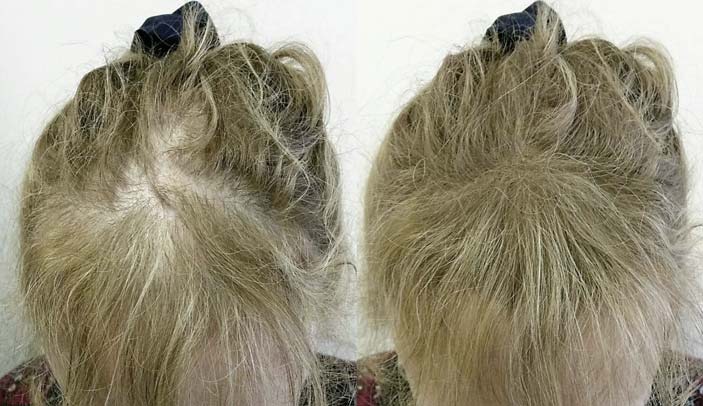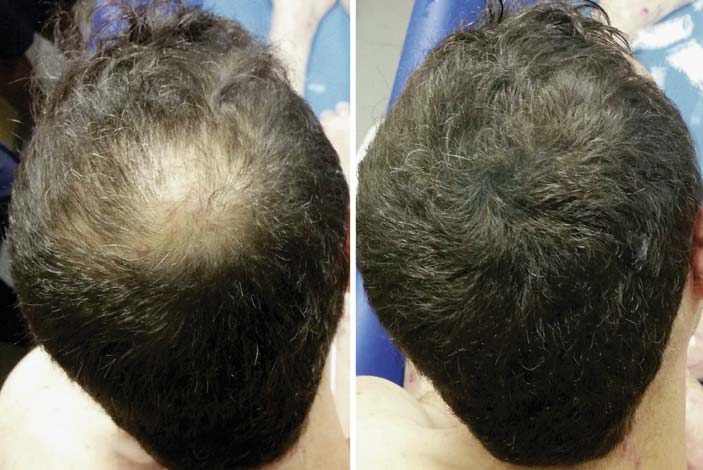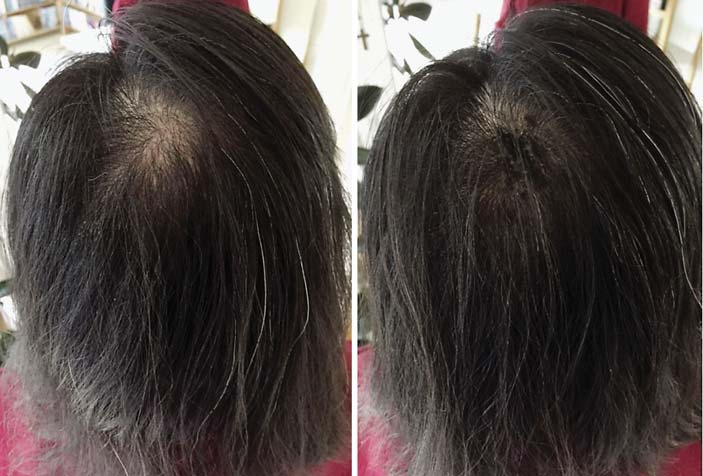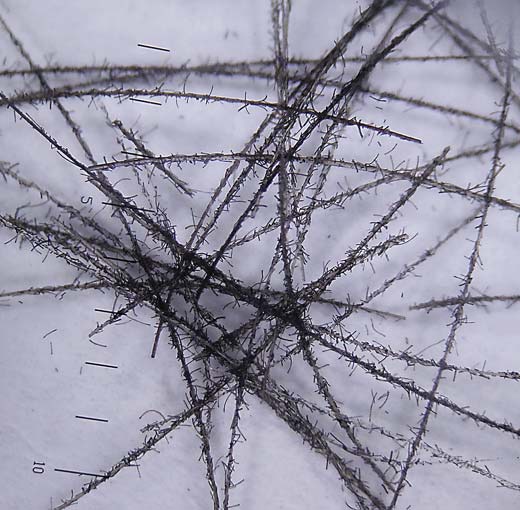Dear Sir,
Scarring alopecia is a known consequence of epidermolysis bullosa (EB), a heterogeneous group of rare heritable skin fragility disorders caused by mutations in genes encoding adhesion proteins within the skin [1,2]. Alopecia is well known to cause reduced quality of life [3,4], further potentiating the morbidity associated with EB [5]. Treatment of alopecia in patients with EB poses a unique challenge because of fragile skin, blistering and wounds, with surgical treatments potentially making alopecia worse. To the best of our knowledge, no specific technique to improve the appearance of scalp alopecia in patients with EB has been published in the medical literature. We therefore aimed to explore the utility of pigmented hair-thickening fibers for the treatment of scalp alopecia in patients with EB.
Patients with EB and scalp alopecia were recruited at routine multidisciplinary EB patient visits. After consent for treatment and publication of case notes and photographs, the patients’ hair color was matched to a specific colored hair-thickening fiber which was then applied topically. The fibers were sprinkled on areas of alopecia using an applicator akin to a saltshaker and then combed through the hair to facilitate distribution. Patients were educated about the use of the pigmented hair-thickening fibers and asked to use them for 1 month, after which they were contacted to report any adverse events.
Three patients with alopecia and EB were recruited for the study. Patient 1, a 41-year-old Caucasian woman with generalized intermediate junctional EB (JEB) had light brown hair. She had a combination of diffuse scarring alopecia and traction alopecia. Patient 2, a 41-year-old Caucasian man, also with generalized intermediate JEB, had dark brown hair. He had a combination of scarring and androgenic alopecia. Patient 3, a 47-year-old Asian woman with recessive dystrophic EB (RDEB) inversa had black hair. Her alopecia was primarily due to scarring.
Immediately after the application, all patients had a notable improvement in the appearance of their alopecia (fig. 1, 2, 3). At the end of the 1-month follow-up period, the 2 patients with JEB continued to use the hair-thickening fibers, but the patient with RDEB stopped because of scalp pruritus due to the fibers. Of note, this patient had a prior history of sensitivity to hair products leading to secondary inflammation.
Fig. 1.

Patient 1, a 41-year old woman with generalized intermediate JEB and scalp alopecia before and after the topical application of pigmented hair-thickening fibers.
Fig. 2.

Patient 2, a 41-year old man with generalized intermediate JEB and scalp alopecia before and after the topical application of pigmented hair-thickening fibers.
Fig. 3.

Patient 3, a 47-year old woman with RDEB inversa and scalp alopecia before and after the topical application of pigmented hair-thickening fibers.
Hair-thickening fibers are one of many new ways to conceal alopecia [6], and Cossman et al. [7] have recently published a study about the effectiveness of hair-thickening fibers in camouflaging areas affected by androgenic alopecia. Hair-thickening fibers work by bonding to the hair by static electricity to make it appear thicker and fuller as well as by sitting on top of the scalp to provide direct camouflage (fig. 4) [8]. The hair-bonding property is a major benefit over other camouflaging techniques but has limited utility in areas of complete hair loss such as in patients with alopecia areata. Hair-thickening fibers tend to be made from either keratin or plant materials, which are dyed in a range of colors to match the patient's hair color. Manufacturers report irritation to be low, and some advocate for a fixative spray to be applied on top of the fibers to improve stability. In our group of patients, we did not use a fixative spray because of concerns about skin irritation. We would also advise against applying hair-thickening fibers to areas of blistered skin or wounds as this could lead to sensitization and future contact allergy to dyes within the fibers.
Fig. 4.

Hair-thickening fibers selected to match black hair shown magnified through the dermatoscope.
Patients with all subtypes of EB can get alopecia, although cicatricial alopecia predominantly affects patients with the severe subtypes of EB, generalized severe RDEB and generalized severe JEB [2]. This is because the affected proteins are present within hair follicles, leading to blistering, scarring and the destruction of hair follicles and subsequent alopecia [9,10]. Patients with EB may develop other common causes of alopecia, including androgenic alopecia, telogen effluvium and traction alopecia [2]. Traction alopecia is particularly prevalent in female patients with severe EB due to hair and skin fragility combined with the trauma of tying the hair into a ponytail to cover existing areas of alopecia [2].
Pigmented hair-thickening fibers may therefore be useful to camouflage areas of alopecia of the scalp in some patients with EB, but they need to be used with caution as they could cause pruritus leading to increased blistering.
Statement of Ethics
The authors have no ethical conflicts to disclose.
Disclosures Statement
No author has any declaration of financial support or relationships that may pose a conflict of interest regarding this paper.
Acknowledgments
We thank Margaret Norris, registered nurse, for assisting the patients, and the Australasian Blistering Diseases Foundation who donated the hair-thickening fibers.
References
- 1.Fine JD, Bruckner-Tuderman L, Eady RA, Bauer EA, Bauer JW, Has C, Heagerty A, Hintner H, Hovnanian A, Jonkman MF, Leigh I, Marinkovich MP, Martinez AE, McGrath JA, Mellerio JE, Moss C, Murrell DF, Shimizu H, Uitto J, Woodley D, Zambruno G. Inherited epidermolysis bullosa: updated recommendations on diagnosis and classification. J Am Acad Dermatol. 2014;70:1103–1126. doi: 10.1016/j.jaad.2014.01.903. [DOI] [PubMed] [Google Scholar]
- 2.Tosti A, Duque-Estrada B, Murrell DF. Alopecia in epidermolysis bullosa. Dermatol Clin. 2010;28:165–169. doi: 10.1016/j.det.2009.10.018. [DOI] [PubMed] [Google Scholar]
- 3.Cartwright T, Endean N, Porter A. Illness perceptions, coping and quality of life in patients with alopecia. Br J Dermatol. 2009;160:1034–1039. doi: 10.1111/j.1365-2133.2008.09014.x. [DOI] [PubMed] [Google Scholar]
- 4.Williamson D, Gonzalez M, Finlay AY. The effect of hair loss on quality of life. J Eur Acad Dermatol Venereol. 2001;15:137–139. doi: 10.1046/j.1468-3083.2001.00229.x. [DOI] [PubMed] [Google Scholar]
- 5.Frew JW, Martin LK, Nijstenà T, Murrell DF. Quality of life evaluation in epidermolysis bullosa (EB) through the development of the QOLEB questionnaire: an EB-specific quality of life instrument. Br J Dermatol. 2009;161:1323–1330. doi: 10.1111/j.1365-2133.2009.09347.x. [DOI] [PubMed] [Google Scholar]
- 6.Donovan JCH, Shapiro RL, Shapiro P, Zupan M, Pierre-Louis M, Hordinsky MK. A review of scalp camouflaging agents and prostheses for individuals with hair loss. Dermatol Online J. 2012;18:1. [PubMed] [Google Scholar]
- 7.Cossman JP, Ladizinski B, Lee KC. Pigmented concealing powders for the hair loss patient. J Cosmet Dermatol. 2013;12:322–324. doi: 10.1111/jocd.12063. [DOI] [PubMed] [Google Scholar]
- 8.You KY, Then YL. Electrostatic and dielectric measurements for hair building fibers from DC to microwave frequencies. Int J Electr Comput Electron Commun Eng. 2015;9:337–344. [Google Scholar]
- 9.Chuang YH, Dean D, Allen J, Dawber R, Wonjnarowska F. Comparison between the expression of basement membrane zone antigens of human interfollicular epidermis and anagen hair follicle using indirect immunofluorescence. Br J Dermatol. 2003;149:274–281. doi: 10.1046/j.1365-2133.2003.05468.x. [DOI] [PubMed] [Google Scholar]
- 10.Joubeh S, Mori O, Owaeibe K, Hashimoto T. Immunofluorescence analysis of the basement membrane zone components in human anagen hair follicles. Exp Dermatol. 2003;12:365–370. doi: 10.1034/j.1600-0625.2002.120402.x. [DOI] [PubMed] [Google Scholar]


